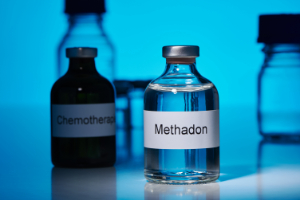Share this
therapeutic drug monitoring for methadone maintenance programs
by Neoteryx Microsampling on Jan 18, 2021 9:00:00 AM
 Methadone is one of the medications approved by the US Food and Drug Administration (FDA) for use in the treatment of Opioid Use Disorder (OUD). It is a long-acting opioid agonist that falls under Schedule II control. This generally means that when prescribed and used under the supervision of a physician, methadone is considered safe and effective and can be used as medication-assisted treatment (MAT) or for pain management. It helps patients achieve and sustain recovery from opioid addiction to lead active and purposeful lives.
Methadone is one of the medications approved by the US Food and Drug Administration (FDA) for use in the treatment of Opioid Use Disorder (OUD). It is a long-acting opioid agonist that falls under Schedule II control. This generally means that when prescribed and used under the supervision of a physician, methadone is considered safe and effective and can be used as medication-assisted treatment (MAT) or for pain management. It helps patients achieve and sustain recovery from opioid addiction to lead active and purposeful lives.
How Methadone Works
The medication works by reducing opioid craving while also managing withdrawal symptoms. Patients are typically advised to take methadone daily in liquid, diskette, or powder form to block the effects of opioids.
How Patients Receive Methadone
SAMHSA (Substance Abuse and Mental Health Services Administration) says patients undergoing methadone treatment must be supervised, as methadone can pose a risk for misuse. Any treatment program dispensing the medication must be SAMHSA-certified.
After patients’ stability is established, they may be allowed to take the medication at home between program visits. This approach to addiction treatment is known as “a whole-person approach.” Its success largely depends on the progress patients demonstrate, and their proven consistent compliance with the required dosage. Some patients on MAT transition to buprenorphine or other MAT medications as directed by their physician.
How long a patient continues with methadone treatment depends on various factors. The National Institute on Drug Abuse indicates the period must be a minimum of 12 months. Patients will work with their MAT practitioner to gradually reduce dosage over time and in a way that prevents withdrawal.
Methadone Safety Control
Methadone is a safe and effective medication, but only when taken as prescribed. Each dose is tailored to the individual patient. Users should never share it with others, something that care providers must monitor and patients who take the medication at home without direct supervision should remember.
Unfortunately, there is a risk of misuse or abuse of methadone by patients. That is why routine drug testing is essential through a therapeutic drug monitoring (TDM) program for methadone.
In some of these programs, patients must physically attend regular clinic appointments for blood collection. This is to measure the amount of methadone present in the blood — blood testing can help detect overuse of the drug, addiction or withdrawal. The concentration levels of methadone in the blood samples will inform the physician how to adjust the dosage safely and effectively, or whether their patient is misusing methadone.
In other programs, more stable patients are allowed to self-collect the blood samples remotely. This is possible with the use of Mitra® devices from Neoteryx. The devices can be sent to patients as a component of at-home specimen collection kits that come with instructions and supplies needed for easy blood collection. Patients can then mail the samples to the clinic or lab for drug testing. More labs now process remote blood "microsamples" from Mitra devices for drug testing and therapeutic drug monitoring. One advantage of blood collection and testing with these devices is that patients cannot easily adulterate, dilute, or substitute their blood samples to try and pass a drug screening.
Importance of Methadone Monitoring
Therapeutic drug monitoring for methadone in addiction recovery patients is crucial for safety and success in recovery. It also helps care providers determine how other medications interact with methadone. Long after the effects of methadone wear off, the active ingredients may remain in the body. Toxic interactions could occur. Monitoring drug concentration levels through blood sampling ensures patients adhere to the prescribed methadone usage to avoid addiction or withdrawal complications and other related hazards.
Looking for a lab that processes remote blood samples for drug testing and therapeutic drug monitoring? Click the icon below to find a microsampling lab near you.
Share this
- Microsampling (206)
- Research, Remote Research (119)
- Venipuncture Alternative (105)
- Clinical Trials, Clinical Research (83)
- Mitra® Device (73)
- Therapeutic Drug Monitoring, TDM (51)
- Dried Blood Spot, DBS (39)
- Biomonitoring, Health, Wellness (30)
- Infectious Disease, Vaccines, COVID-19 (24)
- Blood Microsampling, Serology (23)
- Omics, Multi-Omics (21)
- Decentralized Clinical Trial (DCT) (20)
- Specimen Collection (18)
- Toxicology, Doping, Drug/Alcohol Monitoring, PEth (17)
- Skin Microsampling, Microbiopsy (14)
- hemaPEN® Device (13)
- Preclinical Research, Animal Studies (12)
- Pharmaceuticals, Drug Development (9)
- Harpera Device (7)
- Industry News, Microsampling News (5)
- Antibodies, MAbs (3)
- Company Press Release, Product Press Release (3)
- Environmental Toxins, Exposures (1)
- July 2025 (1)
- May 2025 (1)
- April 2025 (2)
- December 2024 (2)
- November 2024 (1)
- October 2024 (3)
- September 2024 (1)
- June 2024 (1)
- May 2024 (1)
- April 2024 (4)
- March 2024 (1)
- February 2024 (2)
- January 2024 (4)
- December 2023 (3)
- November 2023 (3)
- October 2023 (3)
- September 2023 (3)
- July 2023 (3)
- June 2023 (2)
- April 2023 (2)
- March 2023 (2)
- February 2023 (2)
- January 2023 (3)
- December 2022 (2)
- November 2022 (3)
- October 2022 (4)
- September 2022 (3)
- August 2022 (5)
- July 2022 (2)
- June 2022 (2)
- May 2022 (4)
- April 2022 (3)
- March 2022 (3)
- February 2022 (4)
- January 2022 (5)
- December 2021 (3)
- November 2021 (5)
- October 2021 (3)
- September 2021 (3)
- August 2021 (4)
- July 2021 (4)
- June 2021 (4)
- May 2021 (4)
- April 2021 (3)
- March 2021 (5)
- February 2021 (4)
- January 2021 (4)
- December 2020 (3)
- November 2020 (5)
- October 2020 (4)
- September 2020 (3)
- August 2020 (3)
- July 2020 (6)
- June 2020 (4)
- May 2020 (4)
- April 2020 (3)
- March 2020 (6)
- February 2020 (3)
- January 2020 (4)
- December 2019 (5)
- November 2019 (4)
- October 2019 (2)
- September 2019 (4)
- August 2019 (4)
- July 2019 (3)
- June 2019 (7)
- May 2019 (6)
- April 2019 (5)
- March 2019 (6)
- February 2019 (5)
- January 2019 (8)
- December 2018 (3)
- November 2018 (4)
- October 2018 (7)
- September 2018 (6)
- August 2018 (5)
- July 2018 (8)
- June 2018 (6)
- May 2018 (5)
- April 2018 (6)
- March 2018 (4)
- February 2018 (6)
- January 2018 (4)
- December 2017 (2)
- November 2017 (3)
- October 2017 (2)
- September 2017 (4)
- August 2017 (2)
- July 2017 (4)
- June 2017 (5)
- May 2017 (6)
- April 2017 (6)
- March 2017 (5)
- February 2017 (4)
- January 2017 (1)
- July 2016 (3)
- May 2016 (1)
- April 2016 (2)



No Comments Yet
Let us know what you think